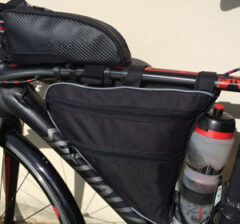This page contains advice on how much water to carry to optimize time efficiency in bikepacking races and long-distance cycling and options of where to store water on the bike.
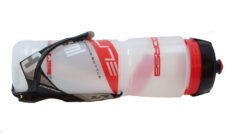
Page Contents:
- Nutrition, Food & Fueling Strategies for Bikepacking Races
- Time Management & Measuring Time Efficiency in Bikepacking Races
Amount of Water
As discussed on the Time Management & Measuring Time Efficiency in Bikepacking Races page, refilling water bottles is one of the most common reasons for stopping when cycling. The time spent looking for places to refill and doing so can be minimized if more water is carried on the bike. In addition, having more water in reserve will minimize the chance of running low and possibly becoming dehydrated, which will certainly reduce cycling speed. When riding at night, it can be a long time between finding places to refill bottles, so it is again wise to have plenty of water capacity.
The small increase in weight caused by extra bottles will have a minimal effect on cycling speed, with 1 kg extra costing only about 3 minutes of cycling time per day (see The Actual Effect of Weight on Cycling Speed page). This time can easily be made up if the extra water capacity means that you can make just one less stop per day and there is no need to fill all bottles all of the time, so the weight penalty is not always there, so the cost in cycling time is probably closer to 1 or 2 minutes per day.
Many bikepackers carry two 750 ml bottles, which I find is often a marginal amount when trying to optimize time efficiency and to guarantee that I stay well hydrated. People with smaller frames and a bikepacking-style frame bag that goes under the full length of the top tube sometimes only have enough space for two 500 ml bottles, which is often not enough (the next page covers Bags). Personally, I like to have three 1-litre bottles, although I don’t always fill all of them. I therefore describe below several ways to increase water-carrying capacity.
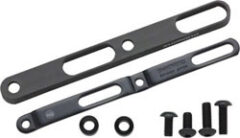
Maximizing the Space Available in the Front Triangle
If your bottle size is limited by the placement of the bottle cages in your frame then an adapter that is designed to allow external Shimano Di2 batteries to be mounted on frames with tight clearances, the Shimano BA-01 (Amazon, see image on the right), allows the height of water bottle cages to be adjusted, which may allow larger bottles to be used. Problem Solvers and Mount Skidmore make similar products. Wolf Tooth Components offer a B-RAD System of mount adapters that allow the position of water bottles to be varied, spares to be strapped beneath the bottles, or even two bottles to be mounted side-by-side from a single water bottle mount (see picture below-right).

A few bottle cages have multiple mounting holes to allow their height to be adjusted, including the Arundel Mandible (which are available in carbon: Amazon or plastic: Amazon). If larger bottles will fit, but the problem is getting them in and out of the cages then a solution is to use a side-entry bottle cage, my preferred model being the Elite Cannibal (Amazon) but there are many others.
On my relatively small bike frame (52cm), I find that a bikepacking-style frame bag that goes under the full length of the top tube doesn’t use the limited space that I have very well. I therefore prefer bags that fill the front two-thirds of the frame’s main triangle, leaving only the rear section free for one large bottle placed vertically (see the next page on Bags).
Mounting Water Bottles Outside of the Front Triangle
Water bottles don’t have to be placed inside the front triangle of the frame. Alternative locations include under the down-tube (just in front of the bottom bracket), behind the saddle (when not using a large seatpost-mounted bag), between the aerobars (or somewhere else near the handlebars), or a hydration bladder can be put inside a frame bag or small backpack.
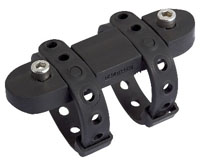
There are many adapters available that allow you to add bottle cages under the down-tube or on any other tube that doesn’t have bosses, many of which are shown in this bikepacking.com article and on this website. My favorite models are the Elite VIP (Amazon) and Decathlon APB 300 (shown on the right).
Because I use a rear rack and rack-top bag instead of a seatpost-mounted bag (see the next page on Bags), I can mount two water bottles behind my saddle. There are many mounts available to do this that are popular with triathletes, the one I use is made by Tacx (Amazon) but I’ve heavily reinforced and modified it to make it more robust and stand up to the challenges of bikepacking. Bottles mounted behind the saddle are far more prone to bounce out on rough terrain than are bottles mounted inside the frame, so it’s better to use bottle cages that have a very firm grasp on the bottle; I find that the Arundel Mandible mentioned above (in carbon: Amazon or plastic: Amazon) works really well.
Profile Design offer a variety of methods for putting a bottle between the Aerobars. However, those require the aerobars to be placed reasonably wide apart and many ultracyclists use this space for navigation and lighting equipment, so the setup needs to be chosen carefully.
Some full frame bags designed for bikepacking incorporate an opening for a hydration hose to come out of so that hydration bladders can be stored inside (e.g., Apidura). Small backpacks with integrated hydration bladders (the best-known brand being CamelBak) are popular with mountain bikers and there are some ultracyclists who use them. Personally, I don’t like wearing a backpack while cycling because it reduces cooling in hot weather and puts strain on my neck and shoulders. Some ultracyclists are happy using this setup, but if you are considering doing so then you should do some Multi-Day Training Rides with it, including in hot weather, before deciding whether to use it during a long race.
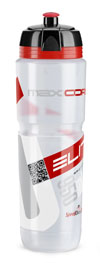
Water Bottle Sizes
There are many brands and models of water bottles available in various sizes. The specific bottles that I use are the Elite MaxiCorsa (Amazon) because they stay reasonably clean, are easy to drink from but don’t drip and they achieve their large capacity by being wider at the top instead of being overly long.
If putting a bottle under the down-tube, a cover should be used to keep the valve clean (e.g., there is a version of the Elite Corsa that has an integrated cover: Amazon).
Last significant page update: November, 2016
This page is in the Bike Accessories section. The next page in this section is:

